Cgfm exam 2 stuvia Study guides, Class notes & Summaries
Looking for the best study guides, study notes and summaries about Cgfm exam 2 stuvia? On this page you'll find 6 study documents about Cgfm exam 2 stuvia.
All 6 results
Sort by
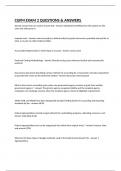
-
CGFM EXAM 2 QUESTIONS & ANSWERS
- Exam (elaborations) • 17 pages • 2024
-
- $10.99
- + learn more
Special assessments are used to ensure that - Answer individuals benefiting from the project are the ones who will pay for it imputed costs - Answer costs incurred by a federal entity for goods and services provided and paid for in total, or in part, by other federal entities Accumulated Depreciation is which type of account - Answer contra asset Preferred Costing Methodology - Answer Directly tracing costs wherever feasible and economically practical due process document describing ...
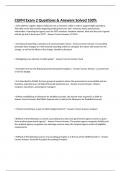
-
CGFM Exam 2 Questions & Answers Solved 100%
- Exam (elaborations) • 20 pages • 2024
-
- $10.19
- + learn more
I 1.The Defense Logistics Agency holds jet fuel as inventory, which it sells to support flight operations. The table on the left provides beginning/ending fiscal year 2017 inventory levels and purchase information. Assuming the agency uses the FIFO inventory valuation method, what was the cost of goods sold for jet fuel in fiscal year 2017? - Answer Correct Answer: $133.50 I 2.In financial reporting, consistency of communication means - Answer Correct Answer: if accounting principles have cha...
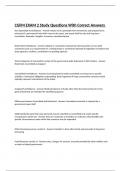
-
CGFM EXAM 2 Study Questions With Correct Answers
- Exam (elaborations) • 20 pages • 2024
-
- $12.49
- + learn more
Non-Spendable Fund Balance - Answer Assets not in spendable form-Inventories and prepaid items, principal of a permanent fund which may not be spent, and assets held for sale and long-term receivables. Examples: Supplies, inventory, membership fees Restricted Fund Balance - Answer Subject to constraints imposed by external parties or law. Debt covenants (such as a requirement for a sinking fund) or constraints imposed by legislation or federal and state agencies, creditors, contributors or gr...
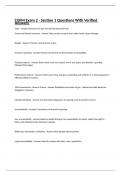
-
CGFM Exam 2 - Section 1 Questions With Verified Answers
- Exam (elaborations) • 23 pages • 2024
-
- $12.49
- + learn more
Taxes - Answer Resources for gov are derived primarily from Grants and shared revenues - Answer Gobs receive revenue from other levels of gov through Budget - Answer Primary control device in gov Financial reporting - Answer Primary mechanism to demonstrate accountability Financial reports - Answer Shows how much was raised, how it was spent, and whether spending followed the budget Performance reports - Answer Inform users how well gov is operating and whether it is achieving goals...
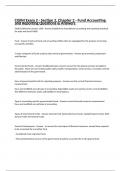
-
CGFM Exam 2 - Section 2, Chapter 2 - Fund Accounting and Reporting Questions & Answers
- Exam (elaborations) • 6 pages • 2024
-
- $10.59
- + learn more
GASB Codification Section 1300 - Answer Establish the foundational accounting and reporting standards for state and local FUNDS Fund - Answer Funds are fiscal and accounting entities that are segregated for the purpose of carrying out specific activities. 3 major categories of funds used by state and local governments - Answer governmental, proprietary and fiduciary. Governmental Funds - Answer Traditionally been used to account for the general services provided to the public. These ser...
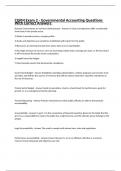
-
CGFM Exam 2 - Governmental Accounting Questions With Correct Answers
- Exam (elaborations) • 3 pages • 2024
-
- $9.49
- + learn more
Reasons Governments are not Run Like Businesses - Answer 1) Goals and objectives differ considerably from those in the private sector. 2) Exists to provide services, not gain profits. 3) Goals and objectives are sometimes established with input from the public. 4) Resources are derived primarily from taxes; there are no shareholders. 5) No single measure of success; can't use increasing market share, earnings per share, or the fact that it is still in business like private sector corporatio...

Did you know that on average a seller on Stuvia earns $82 per month selling study resources? Hmm, hint, hint. Discover all about earning on Stuvia


